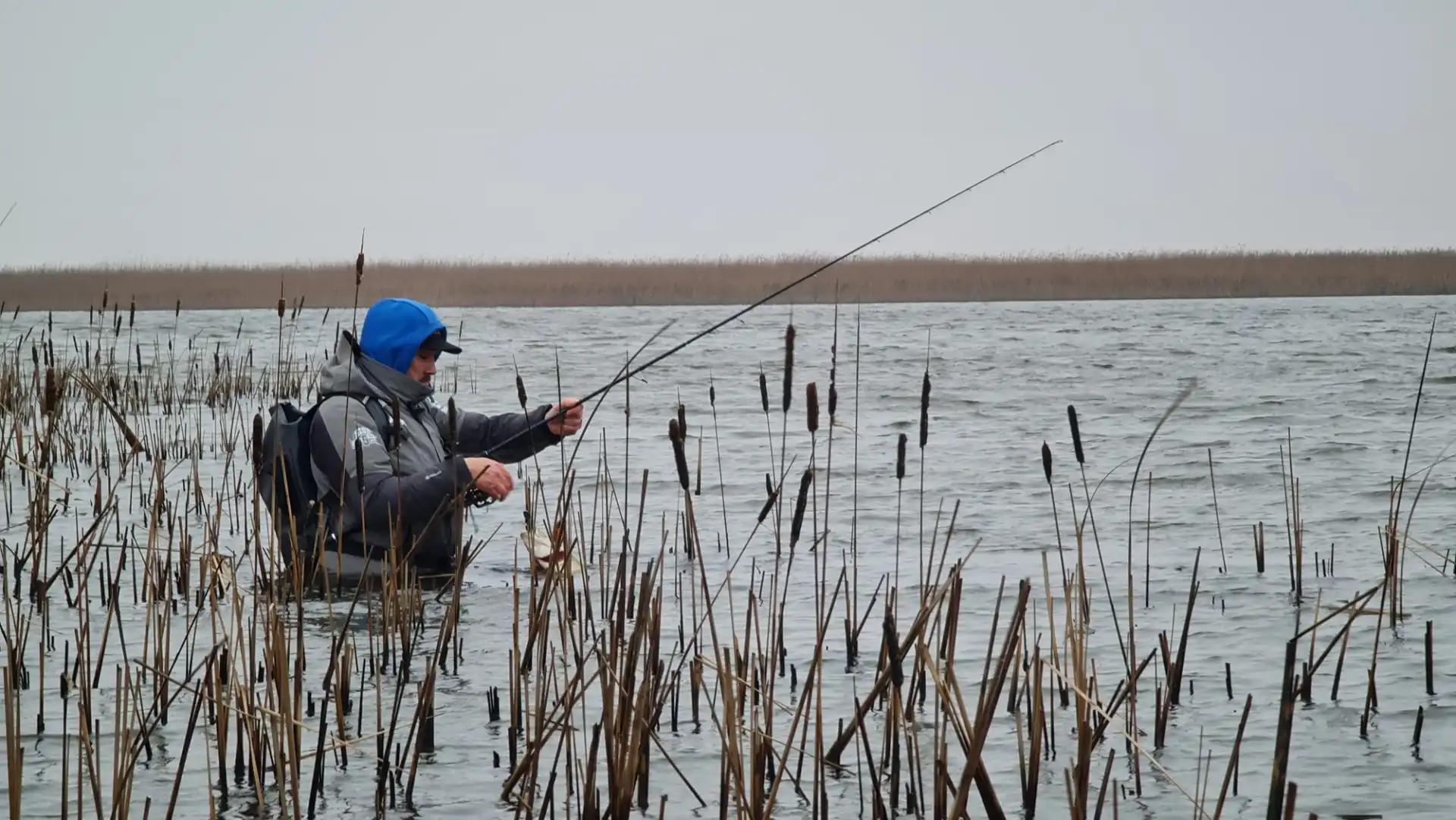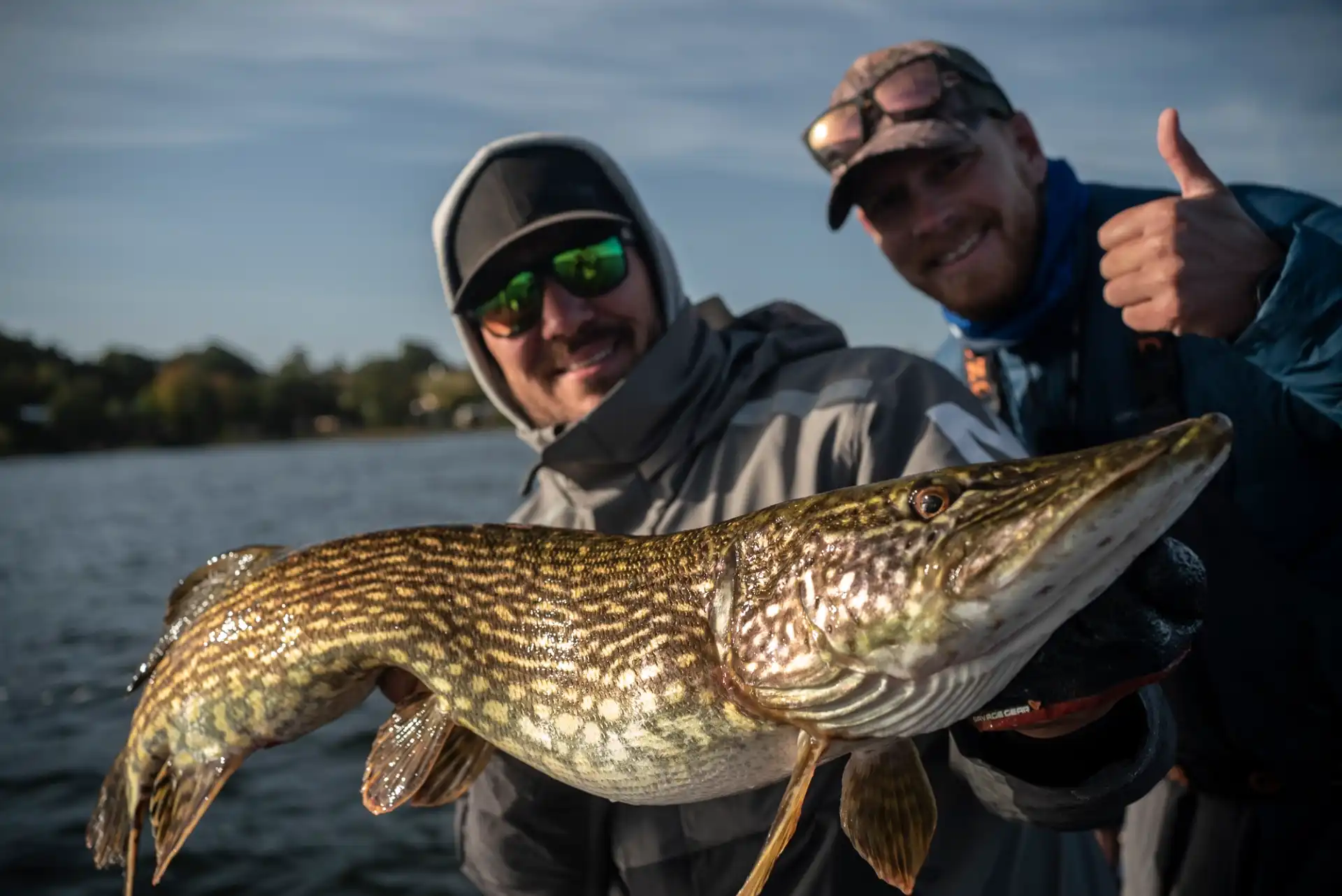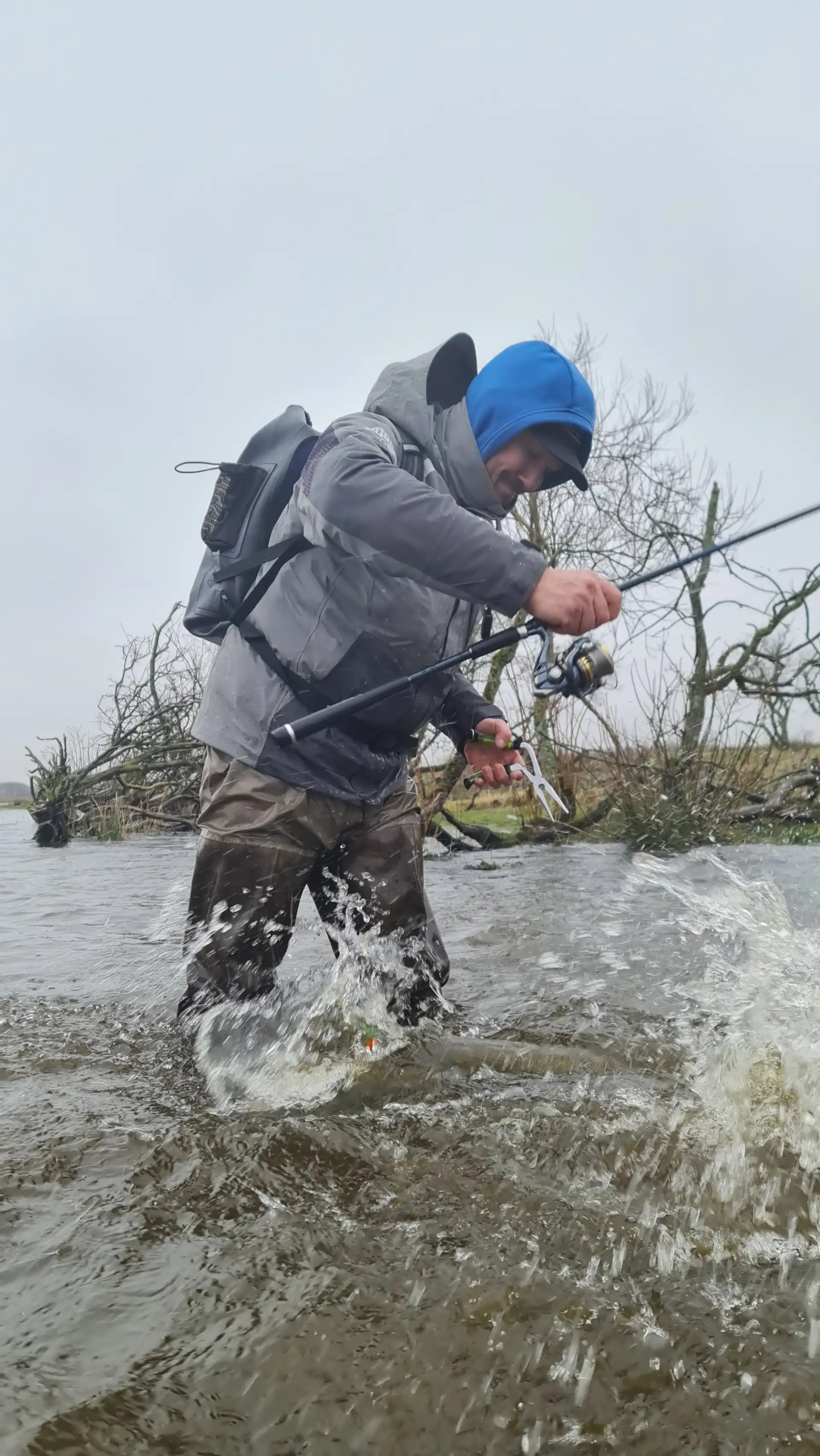NORTHERN PIKE YEAR-END RALLY

Big teeth, big appetite, big aggression — northern pike bring their A-game every time. Now, imaging that drama at close-range and you have the thrilling pursuit of stalking pike on foot.
Indeed, wading for these apex predators presents a pulse-pounding version of a sport many know from the safety and security of a boat. However, for those willing to step into the water, a next-level experience awaits.
Mustad pro and tournament competitor Dennis BomBom Skou knows well this version of pike fishing and his insight provides a blueprint for anglers anywhere pike roam. From Minnesota, to Manitoba and all throughout Europe’s diverse tapestry of lakes and rivers, this adventurous approach to one of freshwater fishing’s most revered species won’t disappoint.

THE BENEFITS
“When wading you can fish in knee-deep water and even shallower too,” Skou said. “I know it sounds crazy, but that’s where we (often) find the pike. Sometimes they are just
sitting there in less than a foot deep water, close to the bank or on a shallow flat out in the open. Sometimes you’re in places where you can’t do that in a boat.
“Another thing I like about wade fishing is that you have a better chance of sneaking up on a pike. Wading is a more stealthy strategy.”
Skou also likes the spontaneity factor. No time-consuming boat or kayak prep; just grab the tackle bag, rod and waders and you’re on your way.
“If you just have a couple of hours to fish, wading can be the perfect choice,” Skou said.
THE RIGHT SPOT
Ask Skou to describe his ideal pike habitat and he describes a place with, at least moderately firm bottom so he can wade without sinking. Starting on secure footing is essential, as wading is often a solitary venture.
“Something that is very important is the hardness of the bottom; I do not want it too muddy, as I would easily sink and become stuck there,” Skou said. “Sometimes, sinking one foot deep is not problem, but if you’re out on your own, you should think twice before you do it. People can have different thoughts about what’s okay, and what’s not, but I never take chances.
“If the mud is too deep you can sink in so much that you are completely stuck. This can be really bad if your waders take in water. A lot of this fishing occurs during the winter months, so getting wet and cold, puts you in serious risk of hypothermia.”
Skou is fond of wading brackish areas in systems that are directly connected to the sea. Two of his favorites, Stege Bugt in Denmark, and Rügen in Germany, exemplify systems with many options.
“These brackish waters are often crystal clear and sometimes they hold crazy amounts of pike,” Skou said. “I also think those pike are way stronger than the ordinary freshwater pike.”
As far as bottom makeup, Skou calls his preference “leopard bottom.” Finding such promising areas requires pre-trip study.
“Before picking out my spot for the day, I go on Google maps to see if the area looks interesting,” Skou said. “This gives me a pretty good idea of the bottom composition, the weed or grass density, and water condition.
“I don’t want a sand desert down there, nor would I want the water to be too deep. I kind of look for a good mix of everything basically. Small open spots with sandy or muddy bottoms and spotted areas with weeds and grass – that’s my go-to area.”
Ultimately, Skou finds his best wading opportunities in areas where prey fish find enough cover in which to hide. When he finds a forage-rich spot, he knows he’ll also find predators lurking there.

BAIT AND TACKLE
The aggressive pike is always game for chasing a moving bait and, for wading use, Skou said he does best with shallow running baits. One of his favorites is the LIVETARGET Erratic Shiner.
“This little spoon has a great action and looks very much like the small baitfish the pike feeds on,” Skou said. “The glow pearl has been one of my best colors. Besides the Erratic Shiner, I generally use smaller baits. The biggest are up to 18 cm.
Other productive wading baits include soft rubber swim baits on Mustad Power Lock Plus Spring Keeper Hook, a LIVETARGET Juvenile Pike Swimbait , LIVETARGET Yellow Perch Crankbait, or a LIVETARGET Yellow Perch Jerkbait.
“Always cast close to the weeds, structure, and drop offs,” Skou advises. “Keep an eye out for fish jumping and if you see a school of baitfish desperately breaking the surface, chances are that a pike is on the hunt! Cast to where you saw them and BAM! Fish on!”
Rod options generally come down to personal preference and the size of pike you’re targeting, however, a 7- to 8-foot, medium-fast Mustad Basscraft spinning rod fits this role well. Featuring an innovative blank construction with LCJ (Longitudinal Carbon Jacket) technology, the Basscraft design ensures a progressive tip curve, with up to 200% greater sensitivity and strength, compared to standard blank construction. For anglers fond of braided line, like TUF-LINE DOMIN8, this rod’s braid-friendly Fuji guides provide the requisite durability.
“I think I have a better reach with a spinning rod and reel than I do with (baitcasting gear),” Skou said. “For braid, I normally go with 0.18mm on a spinning reel and a bit more on a baitcaster.”

ROUNDUP POINTS
Skou offers a couple of insights from his pike experience:
What to Wear: Skou likes the comfort of breathable waders, which allow greater mobility than neoprene. However, for longer wading trips, it’s harder to stay warm in breathable fabric, so he’ll opt for neoprene’s heat retaining advantage.
“For boots, I go for lightweights because I don’t want to walk around carrying too much unnecessary weight,” Skou said. “It’s hard enough to be walking all those kilometers with a heavy backpack full of pike lures. Also, I prefer wading boots with a felt sole for a better grip.
“Under my waders I’m wearing marine wool and fleece. It’s always a gamble trying to pick the right number of layers for the day. It’s very easy to either get too cool or too warm. But during the cold season, it’s easier to predict how it’s going to go and what outfit to wear under your waders. I always have an extra layer on my lower body than I do on my upper body.”
Safety First: One of the most appealing elements of wade fishing for pike is the allure of pushing farther and father to see what the next dozen steps might reveal. Skou understands this, but cautions anglers to maintain their awareness.
“Be careful not to go out too far, because if the tide suddenly becomes high, the water level can rise super-fast,” he said. “This can put you in a situation where you can’t get back to shore without a swim. You don’t want to swim in your waders, leaving behind all your gear.
“If you’re going out alone, or if your group is spread across a bigger area, you could consider wearing an inflatable life jacket. If you find yourself in a dangerous situation, wearing a life jacket may turn out to be your best decision you ever made.”
Skou said a wading staff can be helpful in defining bottom conditions and choosing your steps wisely. If you’re wading in high weeds, that staff can help you locate holes, rocks or other tripping hazards before they become a problem.
Reference Points: Every productive trip offers something that can facilitate future success. Skou knows this and records key details from each of his wading excursions.
“For a better understanding of your water, keep a log on your trips,” he said. “In time you will learn when you’ll have the best chances for a successful fishing trip. If you catch fish, take notice of water temperature, water level, tide stage, wind direction and so on. You will be surprised how much of a help this can be.”
All of these points matter because they combine to create the opportunity to experience a truly spectacular moment. Wade fishing brings you closer to the action than anything you’ll experience from a boat and that’s a memory you don’t want to miss.
“It’s very addictive to fish for pike like that,” Skou said. “Standing in the water right next to them as you are hand landing them, unhooking them, and releasing them to see them swim off — very cool!”






